Intel Core i7-10700 vs Core i7-10700K Review: Is 65W Comet Lake an Option?
by Dr. Ian Cutress on January 21, 2021 10:30 AM EST- Posted in
- CPUs
- Intel
- Core i7
- Z490
- 10th Gen Core
- Comet Lake
- i7-10700K
- i7-10700
Gaming Tests: World of Tanks
Albeit different to most of the other commonly played MMO or massively multiplayer online games, World of Tanks is set in the mid-20th century and allows players to take control of a range of military based armored vehicles. World of Tanks (WoT) is developed and published by Wargaming who are based in Belarus, with the game’s soundtrack being primarily composed by Belarusian composer Sergey Khmelevsky. The game offers multiple entry points including a free-to-play element as well as allowing players to pay a fee to open up more features. One of the most interesting things about this tank based MMO is that it achieved eSports status when it debuted at the World Cyber Games back in 2012.
World of Tanks enCore is a demo application for its new graphics engine penned by the Wargaming development team. Over time the new core engine has been implemented into the full game upgrading the games visuals with key elements such as improved water, flora, shadows, lighting as well as other objects such as buildings. The World of Tanks enCore demo app not only offers up insight into the impending game engine changes, but allows users to check system performance to see if the new engine runs optimally on their system. There is technically a Ray Tracing version of the enCore benchmark now available, however because it can’t be deployed standalone without the installer, we decided against using it. If that gets fixed, then we can look into it.
The benchmark tool comes with a number of presets:
- 768p Minimum, 1080p Standard, 1080p Max, 4K Max (not a preset)
The odd one out is the 4K Max preset, because the benchmark doesn’t automatically have a 4K option – to get this we edit the acceptable resolutions ini file, and then we can select 4K. The benchmark outputs its own results file, with frame times, making it very easy to parse the data needed for average and percentiles.
| AnandTech | Low Resolution Low Quality |
Medium Resolution Low Quality |
High Resolution Low Quality |
Medium Resolution Max Quality |
| Average FPS | 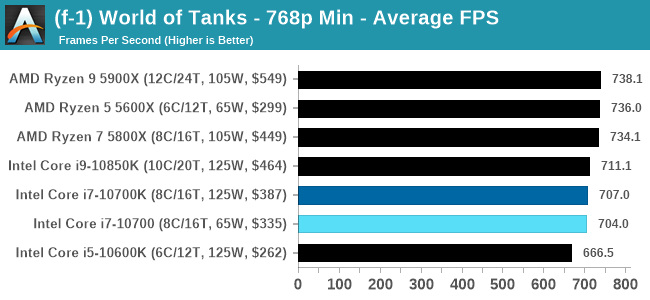 |
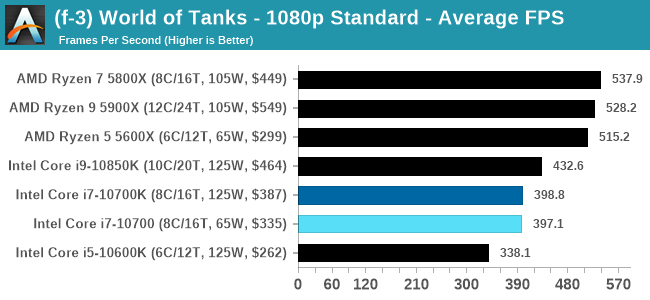 |
 |
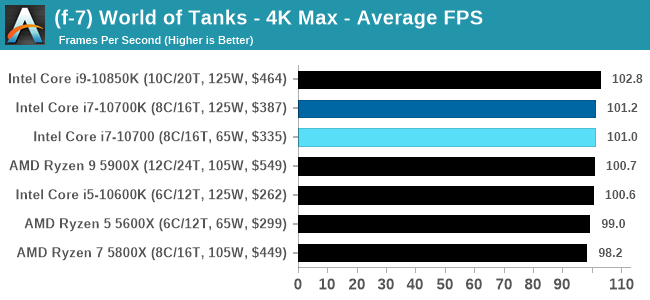 |
| 95th Percentile | 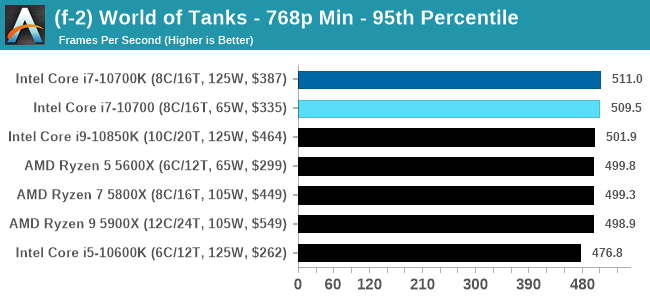 |
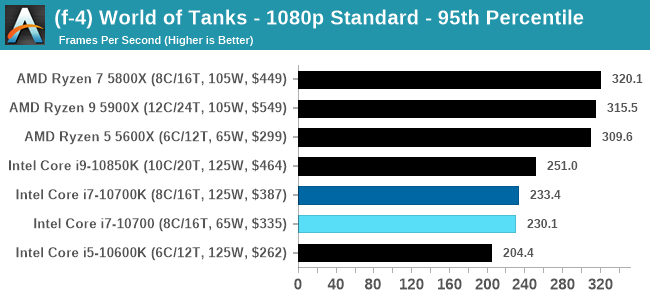 |
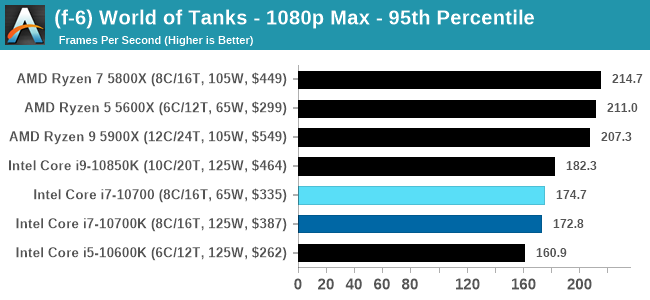 |
 |
All of our benchmark results can also be found in our benchmark engine, Bench.


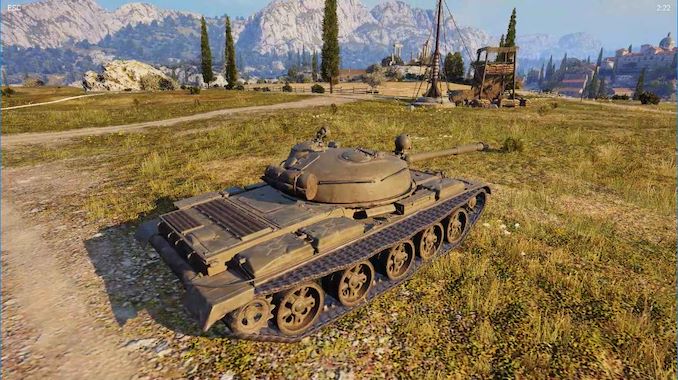









210 Comments
View All Comments
blckgrffn - Thursday, January 21, 2021 - link
Thanks for the review, as it basically shows what other reviews already show, namely if you set aggressive PL1 and PL2 values across K & non K SKUs then you'll get similar performance.I am curious why you said the performance is much lower with a 65W power limit and then didn't include those results.
I feel like it is common knowledge, especially with 10th Gen Intel CPUs that you need to manually configure PL1 and PL2 in keeping with your cooling solution, but perhaps not.
blckgrffn - Thursday, January 21, 2021 - link
I mean, published PL1 for this CPU is 10700 is 65, PL2 is 224 for 28 seconds.Running outside of those value is essentially turbo overclocking (yeah, I know Intel has also redefined that term).
If your motherboard auto overclocks the CPU via a ridiculous PL1 value then ¯\_(ツ)_/¯
Tunnah - Thursday, January 21, 2021 - link
Intel has no incentive to change their policy and label their products with the actual power draw they'll be using because they'll show how much more they suck up compared to AMD. People are constantly looking for metrics to compare the 2 "teams", and Intel getting to keep the labels of 65w and 125w lets the fans say "see it has the same power usage as AMD!"yeeeeman - Thursday, January 21, 2021 - link
this looks just fine to me as long as it is clear for the user.magreen - Friday, January 22, 2021 - link
But it is not.porina - Thursday, January 21, 2021 - link
From my observations of Zen 2 at stock operation, 65W TDP models tended to sit continuously at the 88W PPT limit under most all-core load conditions. Has this changed with Zen 3? Do they not hit 88W so easily, or is another (current) limiter taking over? Or is the limit a different value now?Smell This - Friday, January 22, 2021 - link
Presumably, the Zen3 would operate under the same 'constraints' ----- The constraints are as follows:
♦ Package Power Tracking (PPT): The power threshold that is allowed to be delivered to the socket. This is 88W for 65W TDP processors, and 142W for 105W TDP processors.
♦ Thermal Design Current (TDC): The maximum amount of current delivered by the motherboard’s voltage regulators when under thermally constrained scenarios (high temperatures). This is 60A for 65W TDP processors, and 95A for 105W TDP processors.
♦ Electrical Design Current (EDC): This is the maximum amount of current at any instantaneous short period of time that can be delivered by the motherboard’s voltage regulators. This is 90A for 65W TDP processors, and 140A for 105W TDP processors.
"Looking at the total power consumption of the new 3700X, the chip is very much seemingly hitting and maintaining the 88W PPT limitations of the default settings, and we’re measuring 90W peak consumption across the package."
Olaf van der Spek - Thursday, January 21, 2021 - link
Why would one want to limit turbo budgets? Thermals? If there's no thermal headroom the CPU won't turbo (as far).Efficiency?
Calin - Friday, January 22, 2021 - link
The motherboard has power limits - both in instant maximum current from the voltage regulation phase (remember, the mainboard receives 3.3 Volts, 5V, 12V and maybe -5V and -12V from the PSU and has to convert that to processor voltage), and in cooling capacity for the VRM (Voltage Regulation Module).Regardless of the power limits, the processor will slow down if its internal temperature is too great.
So yes, the "my mainboard's power delivery module cannot deliver more than 80 amps" is a possible reason. Another would be "My case has bad cooling and I want to keep the processor colder". Another would be "As soon as the sustained power goes over 140 watts, the fans in the case start whirring and I hate the sound".
DominionSeraph - Thursday, January 21, 2021 - link
>This does come with a reasonably good default cooler.No. Just no. The Ryzen coolers are utter trash and you're doing a disservice to your readers who may not have ever had a quiet cooler to say otherwise. I build PCs and I've had several Ryzens go through and I have never seen one where I would call the acoustics livable. My first sale was a 1700 with the stock cooler since I didn't have any other AM4 compatible ones at the time and I still feel bad about selling it that way. It was just terrible. The 212 EVO seems to be within its thermal envelope for quiet cooling up to a stock 3700X, so I'd highly recommend one of those over the stock cooler. Going above the ~85W of a 3700X you should spring for a Fuma 2.